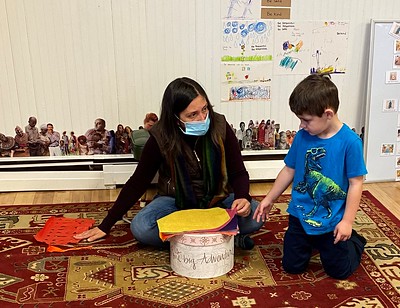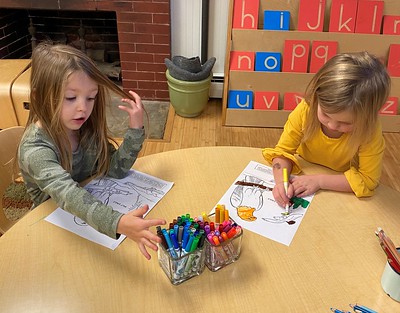The artist Paul Klee is known for both his use of shape and line. We read The Cat and the Bird by Geraldine Elschner, which she wrote based on Klee’s painting Cat and Bird. After checking out Castle and Sun and several other Paul Klee works of art, the children used shapes to create their own colorful pictures.
During Sign on Tuesday we reviewed all the bird and bird related signs, the alphabet, numbers to ten, then counting by 10’s to 100. We then read and signed the story chant Five Little Pumpkins. To finish off we sang and signed the Five Little Chickadees song.
Zeanny introduced Dia de los Muertos during Spanish. She shared how on this day in Mexico it is believed that those family members who have passed away can come back to visit for one day. People have a huge celebration with lots of food and parades and they visit the gravesites of their loved ones and dress up as skeletons. She showed us a clip from the movie Coco, which portrays real life customs during Dia de los Muertos. We then learned how to make flores (flowers) for the dead and papel picado (perforated paper). Everyone chose some tissue paper and made either a flores or papel picado, or both, to display in the classroom. Zeanny then gave everyone a treat before she left.
Kindergarten students played pumpkin addition BINGO, did some sight word word searches, and chose some of their own work to complete. Some students have been doing some initial work with sounding out consonant vowel consonant words that rhyme, preparing our mouths for the initial sound then sliding through the subsequent two sounds.
Some students spent a lot of time outside this week expending energy! And others preferred some inside time with lots of Memory and stories.
Friday students discussed how they eat their food with teeth and what types of food we eat. We talked about what birds eat and how they don’t have teeth but do have beaks, then read some stories about bird beaks. We looked at pictures of different foods birds eat and then the children did some experimenting with tools that represented different types of beaks. They had 6 tools and 6 types of food and had to find the best type of “beak” for eating each food. They had pliers, tweezers, a straw, a skewer, a fork and knife, and a strainer. They then figured out how to eat small floating water plants, a marshmallow “mouse,” nectar from a flower, worms in dirt, sunflower seeds, and a fish in shallow water. After experimenting we matched the “beaks” to each type of bird and their food source.















































